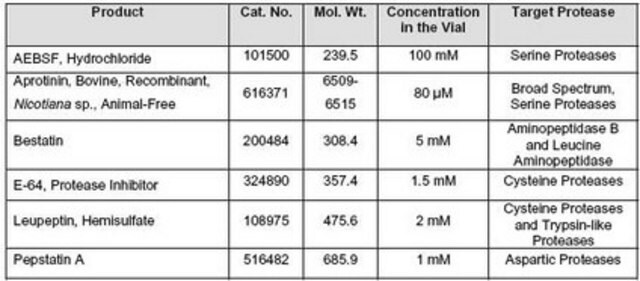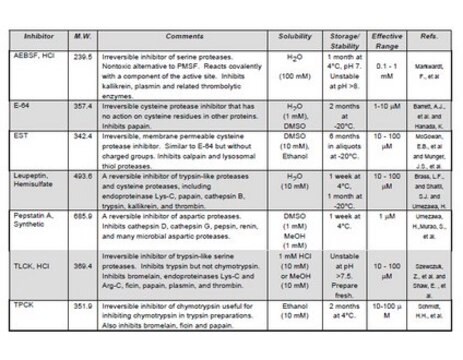539137
Protease Inhibitor Cocktail V
EDTA-Free, lyophilized, A cocktail of four protease inhibitors for the inhibition of serine, cysteine, but not metalloproteases.
Synonim(y):
Inhibitor proteazy bez EDTA
About This Item
Polecane produkty
Nazwa produktu
Protease Inhibitor Cocktail Set V, EDTA-Free, A cocktail of four protease inhibitors for the inhibition of serine, cysteine, but not metalloproteases.
Poziom jakości
Formularz
lyophilized
producent / nazwa handlowa
Calbiochem®
warunki przechowywania
OK to freeze
desiccated (hygroscopic)
Warunki transportu
wet ice
temp. przechowywania
−20°C
Opis ogólny
Specyficzność
Działania biochem./fizjol.
Serine and cysteine proteases, but not metalloproteases
Ostrzeżenie
Rekonstytucja
Informacje prawne
Hasło ostrzegawcze
Danger
Zwroty wskazujące rodzaj zagrożenia
Zwroty wskazujące środki ostrożności
Klasyfikacja zagrożeń
Eye Dam. 1 - Skin Corr. 1A
Kod klasy składowania
8A - Combustible corrosive hazardous materials
Klasa zagrożenia wodnego (WGK)
WGK 3
Certyfikaty analizy (CoA)
Poszukaj Certyfikaty analizy (CoA), wpisując numer partii/serii produktów. Numery serii i partii można znaleźć na etykiecie produktu po słowach „seria” lub „partia”.
Masz już ten produkt?
Dokumenty związane z niedawno zakupionymi produktami zostały zamieszczone w Bibliotece dokumentów.
Klienci oglądali również te produkty
Nasz zespół naukowców ma doświadczenie we wszystkich obszarach badań, w tym w naukach przyrodniczych, materiałoznawstwie, syntezie chemicznej, chromatografii, analityce i wielu innych dziedzinach.
Skontaktuj się z zespołem ds. pomocy technicznej
















